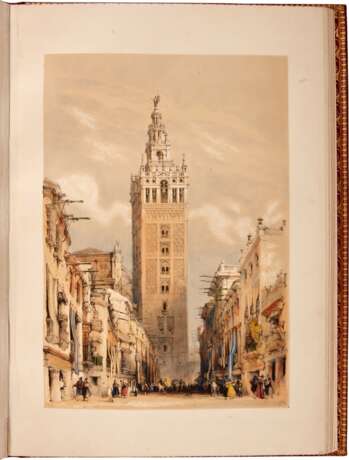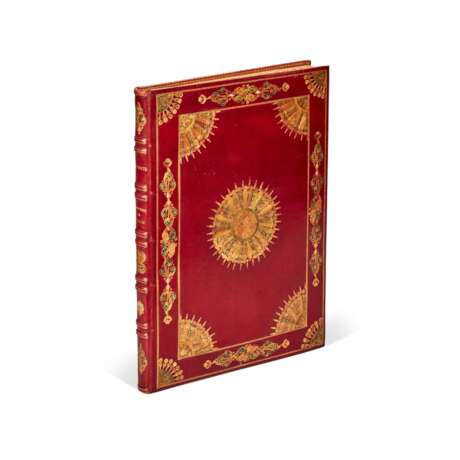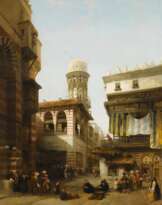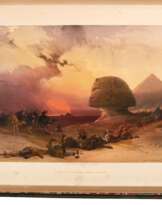ID 1076593
Lot 70 | David Roberts | Picturesque sketches in Spain. London, 1832-1833, in a fine Spanish binding by Hijos de V. Arias
Estimate value
£ 10 000 – 15 000
Picturesque sketches in Spain taken during ye years 1832 & 1833. London: Hodgson & Graves, 1837
FIRST EDITION, folio (530 x 380mm.), lithographed title page with depiction of the entrance to the Chapel of Ferdinand and Isabella, engraved dedication leaf with list of plates on verso, 25 fine lithographs, finely hand-coloured by a later hand, CRIMSON STRAIGHT-GRAINED MOROCCO, GILT AND PAINTED BY HIJOS DE V. ARIAS, covers with large central wheel medallion with citron centre, citron, green, and gilt spokes, all with elaborate gilt tooling, central panel with gilt-rule border and fan cornerpieces in the gilt and painted style of the centrepiece, the whole enclosed in a frame with painted and gilt floral sidepieces and quarter-circle cornerpieces spine gilt, wide turn-ins gilt, pink embroidered silk doublures and free endleaves, top edge gilt and gauffered
THE WORK THAT BROUGHT LANDSCAPE ARTIST DAVID ROBERTS TO THE ATTENTION OF THE PUBLIC and prompted art critic John Ruskin to praise his “absolutely careful and faithful” depiction of “the greatness and richness of things.” For Ruskin, it also allowed one to imagine “serenely and joyfully… the splendour of the aisles of Seville, or the strength of the towers of Granada, and [to forget] oneself, for a time.”
Roberts (1796-1864) had shown artistic ability at an early age, and was apprenticed at age ten to a house painter who did decorative interiors for clients like Sir Walter Scott. After completing his apprenticeship, Roberts supported himself and his family as a theatrical scene designer and painter in Edinburgh and London, all the while continuing to create oil paintings of landscapes, which he showed and sold at exhibitions. ODNB notes that “Roberts was quick to see the potential of reproducing his sketches as prints, to reach a wider audience,” and he pursued this means of monetizing the sketches and paintings he made on his travels. He had sold some individual prints and small collections of sketches, but Spain was his first work to be issued as a large format book. According to Abbey, he was paid £350 for the drawings and for supervising and touching up the lithography stones as needed. Roberts went above and beyond this request, doing some of the drawings on stone himself, and refining every one. His efforts paid off: according to ODNB, “The prints (both authorized and pirated copies) brought him widespread fame and popularity, and are still sold as souvenirs to this day.”
Appropriate to the subject matter, this copy is in an ornate Spanish binding by the sons and successors of Madrid bookbinder Victorio Arias y Lopez (1856–1935), who trained in the leading Madrid workshops of the second half of the 19th century before opening his own bindery in 1885. According to Valdés and Bautista’s article on “Artistic Bookbindings in the Guerra Fund” in “Pecia Complutense” (2011), “The works of his workshop are highly esteemed, both in Spain and abroad, having been awarded prizes in numerous Exhibitions and Contests. He carried out numerous commissions for the Royal House and for bibliophiles and booksellers such as the Marquis of Laurencin, the Count of Vilches or Guillermo de Osma.” The present binding resembles a Spanish style of the 19th century, elaborately decorated with gold stamps and tooling, accented with colours.
| Artist: | David Roberts (1796 - 1864) |
|---|---|
| Auction house category: | Prints, graphics, books |
| Artist: | David Roberts (1796 - 1864) |
|---|---|
| Auction house category: | Prints, graphics, books |
| Address of auction |
Sotheby´s 34-35 New Bond Street W1A 2AA London United Kingdom | |
|---|---|---|
| Preview |
| |
| Phone | +44 (0) 20 7293 5000 | |
| Phone | +1 212 606 7000 | |
| Conditions of purchase | Conditions of purchase |








